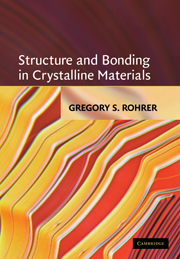Book contents
- Frontmatter
- Contents
- Preface
- 1 Introduction
- 2 Basic Structural Concepts
- 3 Symmetry in Crystal Structures
- 4 Crystal Structures
- 5 Diffraction
- 6 Secondary Bonding
- 7 Ionic Bonding
- 8 Metallic Bonding
- 9 Covalent Bonding
- 10 Models for Predicting Phase Stability and Structure
- Appendix 1A Crystal and univalent radii
- Appendix 2A Computing distances using the metric tensor
- Appendix 2B Computing unit cell volumes
- Appendix 2C Computing interplanar spacings
- Appendix 3A The 230 space groups
- Appendix 3B Selected crystal structure data
- Appendix 5A Introduction to Fourier series
- Appendix 5B Coefficients for atomic scattering factors
- Appendix 7A Evaluation of the Madelung constant
- Appendix 7B Ionic radii for halides and chalcogenides
- Appendix 7C Pauling electronegativities
- Appendix 9A Cohesive energies and band gap data
- Appendix 9B Atomic orbitals and the electronic structure of the atom
- Index
7 - Ionic Bonding
Published online by Cambridge University Press: 23 February 2011
- Frontmatter
- Contents
- Preface
- 1 Introduction
- 2 Basic Structural Concepts
- 3 Symmetry in Crystal Structures
- 4 Crystal Structures
- 5 Diffraction
- 6 Secondary Bonding
- 7 Ionic Bonding
- 8 Metallic Bonding
- 9 Covalent Bonding
- 10 Models for Predicting Phase Stability and Structure
- Appendix 1A Crystal and univalent radii
- Appendix 2A Computing distances using the metric tensor
- Appendix 2B Computing unit cell volumes
- Appendix 2C Computing interplanar spacings
- Appendix 3A The 230 space groups
- Appendix 3B Selected crystal structure data
- Appendix 5A Introduction to Fourier series
- Appendix 5B Coefficients for atomic scattering factors
- Appendix 7A Evaluation of the Madelung constant
- Appendix 7B Ionic radii for halides and chalcogenides
- Appendix 7C Pauling electronegativities
- Appendix 9A Cohesive energies and band gap data
- Appendix 9B Atomic orbitals and the electronic structure of the atom
- Index
Summary
Introduction
The ionic bonding model describes the limiting case in which an electron is transferred from the outer orbital of an electropositive atom to an empty outer orbital of an electronegative atom. The results is two charged species, an anion (−) and a cation (+). Again, we see that the cohesive force is electrostatic in origin. Ideally, there is no further interaction between the electrons on each of the ions. In other words, only the occupation of the electronic states associated with each atom changes, not the energy levels of the states. As with the other bonding models, this describes only the limiting case and does not accurately reflect all that is known about ionic crystals. Nevertheless, we will see that a quantitative model based on these assumptions works surprisingly well. We should also note that while secondary, metallic, and covalent bonds can be formed between identical atoms, ionic bonds only form between different types of atoms.
Solids that are held together by ionic bonds
Any compound that forms between a halide (group VIIA) or chalcogenide (group VIA) and an alkali metal (group IA), an alkaline earth metal (group IIA), or a transition metal (B groups) is usually said to be ionic. The criterion defined in Chapter 1, Section D, is that the Pauling electronegativity difference must be greater than 1.7. Ionic bonds are primarily found in extended crystalline structures, but they occasionally also occur in simple molecules. Our interests lie with the crystalline solids.
- Type
- Chapter
- Information
- Structure and Bonding in Crystalline Materials , pp. 286 - 325Publisher: Cambridge University PressPrint publication year: 2001

